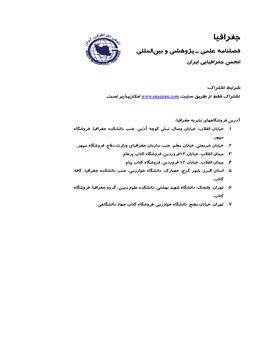The Persian Turquoise mining at Neyshabur mine in historical times
Subject Areas :bahareh osanlou 1 , Zahra HashemiDehaghi 2 , Seyedeh Mahya Seyedan 3
1 -
2 -
3 -
Keywords: Old mining, turquoise, Neyshabur, NE of Iran,
Abstract :
Persian turquoise is well known in the world from ancient times. At least from 7000 years ago, turquoise was extracted from Neyshabur mine in NE of Iran. Gradually, the turquoise mining at Neyshabur mine extended and by the use of some instruments suitable for breaking the rocks and making tunnels following the veins continued. In several references, picks and crowbars are mentioned for mining instruments. In 1850’s the gunpowder was used for the first time in the mines and increased the mining speed but in despite, by lessening the size of extracted Turquoises decreased its value, dramatically. Up to the end of Safavid dynasty, the mines were extracted under the supervision of the government and the mines were stable enough to extend the mining activity but by powering the Qajar dynasty, the mines were extracted by local governments as well as individual persons lacking the science of mining resulted in destroying the mines. As a consequence, at the end of the Qajar dynasty, almost all the mines were totally filled by water and rocks and Persian Turquoise lost its position in world markets.
1. ابن¬حوقل، قرن چهارم ه.ق (1354)، صورت¬الارض، ترجمه دکتر جعفر شعار، بنیاد فرهنگ ایران؛ جوهری نیشابوری، محمدبن ابی¬البرکات، قرن ششم ه.ق.، جواهرنامه نظامی، به کوشش ایرج افشار، تهران، میراث مکتوب، 1383، چاپ اول، 446 صفحه؛
2. دنیسری، شمسالدین محمدبن امین¬الدین ایوب، 669 ه.ق (1350)، نوادرالتبادر لتحفة البهادر، به کوشش محمدتقی دانش پژوه و ایرج افشار، بنیاد فرهنگ ایران، 1350، 380 صفحه؛
3. رحمتی، محسن؛ دادی گراوند، مظفرعلی؛ حق نظری، هادی؛ گراوند، نجیمه؛ (1392)، تأثیر سلجوقیان بر اوضاع تجاری بازرگانی نیشابور، فصلنامه علمی ـ پژوهشی تاریخ اسلام، سال چهاردهم، شماره سوم، 151-174؛
4. طوسی، نصیرالدین، 597-672 ه.ق (1363)، تنسوخ¬نامه ایلخانی، نشر تهران، اطلاعات، چاپ دوم، 358 صفحه؛
5. کلاویخو، گونزالز، 1412، (1374)، سفرنامه، ترجمه مسعود رجبنیا، انتشارات علمی و فرهنگی، 387 صفحه؛
6. گاراژیان، عمران؛ لطفی¬قرائی، فرزانه (1393)، باستانشناسی فیروزه: انسان، سنگ و رنگ، دو فصلنامه علمی ـ پژوهشی پژوهشهای انسانشناسی ایران، دوره چهارم، شماره دوم، 105-124؛
7. گاراژیان، عمران؛ لطفی قرائی، فرزانه (1393)، فیروزه در پیش از تاریخ فلات ایران فرهنگهای روستانشینی و شهرنشینی، دو فصلنامه علمی ـ تحلیلی هنر و فن، شماره سوم، بهار و تابستان، 45-66؛
8. مستوفی، حمدالله، نزهته القلوب، 740 ه.ق (1362)، به اهتمام و تصحیح گای¬لسترنج، انتشارات دنیای کتاب، 1362؛
9. منصور، محمد، قرن نهم ه.ق.، گوهرنامه، به کوشش منوچهر ستوده، 118 صفحه؛
10. ییت، چارلز اداوارد، 1900، (1365)، خراسان و سیستان، به کوشش قدرتالله روشنی و مهرداد رهبری، انتشارات یزدان، 477 صفحه؛
11. Curzen, G.N., (2001), Iran and the Issue of Iran;
12. Diakonoff, I.M. and Midii, I., (1956), History of Media;
13. Flannery, H., and Neely, J., (1969), Prehistory and Human Ecology of Deh Luran Plain;
14. Fraser, J.B., (1825), Narrative of a journey into Khorasān: In the Years 1821 and (1822), Including Some Account of the Countries to the North-east of Persia; with remarks upon the national character, Government, and Resources of that Kingdom. Longman, Hurst, Rees, Orme, Brown, and Green;
15. Ghirshman, R., (1954), Iran [L'Iran des origines à l'Islam, engl.] From the earliest times to the Islamic conquest;
16. King, R.J., (2002), Turquoise. Geology Today, 18(3), pp.110-114.
17. Lowry, J.D., (2010), Turquoise. Gibbs Smith;
18. Needler, W. and Graham, J.W., 1953. Jewellery of the ancient world. Bull. Roy. Ont. MA, 20, pp.1-36;
19. Pogue, J.E., (1915), The turquois: a study of its history, mineralogy, geology, ethnology, archaeology, mythology, folklore, and technology (Vol. 12, No. 2-3). Rio Grande Press Inc;
20. Polak, J.E., (1982), The Polak’s Travel book; Iran and Iranians. Translation by Jahandari K. Tehran: Kharazmi Publication, pp.474-475.
21. Streeter, E.W., (1892), Precious stones and gems: Their history, sources and characteristics. Рипол Классик;
22. Wulff, H.E., (1966), The traditional crafts of Persia. MIT Press.


